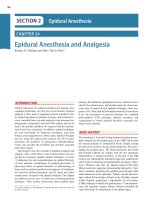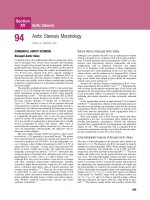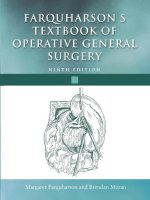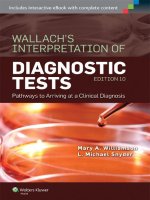Ebook Herzog''s CCU: Part 2
Bạn đang xem bản rút gọn của tài liệu. Xem và tải ngay bản đầy đủ của tài liệu tại đây (12.12 MB, 982 trang )
AcuteAorticSyndrome
INTRODUCTION
Acute aortic syndrome (AAS) represents a spectrum of life-threatening
conditions with similar clinical presentation and the need for urgent
management. It includes classic acute aortic dissection (CAAD), intramural
hematoma(IMH),andpenetratingaorticulcer(PAU).Althoughnotincludedin
the original definition of AAS, traumatic aortic rupture (TAR) and aortic
aneurysmrupturehavealsobeenconsideredtobepartoftheAASspectrum.
AAS is characterized by disruption of the media layer of the aorta and
typicallypresentswithacutechestpain.Theterm“acuteaorticsyndrome”was
firstcoinedin2001bytheSpanishcardiologistsVilacostaandSanRomán,who
describedAASasaspectrumofinterlinkedlesions1withtheintenttoincrease
awarenessandtospeedupdiagnosisandappropriatetreatment(Figure32.1).
FIGURE32.1Acuteaorticsyndrome.TheacuteaorticsyndrometriadfirstdescribedbyVilacostaandSan
Román.Arrowssignifypossibleprogressionofaorticlesions(penetratingaorticulcertoIMH,penetrating
aorticulcertoclassicdissection,IMHtoclassicdissection).IMH,intramuralhematoma.
AlthoughtheincidenceofAASislowerthanthatofacutecoronarysyndrome
(ACS),AAScarriesahighermortality,andisthereforeacriticalcomponentof
thedifferentialdiagnosisofchestpainintheCardiacCareUnit(CCU).Overall
incidenceofAASsis2to4casesper100,000individuals.BecauseAASisrare,
the International Registry of Acute Aortic Dissection (IRAD) was created in
1996asawaytocombinedataacquiredfrommultipletopinstitutionsinEurope,
North America, and Asia.2 The 2010 intersocietal guidelines for the diagnosis
and management of patients with thoracic aortic disease proposed a standard
approachtothediagnosisandtreatmentofAAS.3
Althoughclinicalhistoryandphysicalexaminationareimportant,imagingis
essential in the diagnosis of AAS. Transesophageal echocardiography (TEE),
computed tomography (CT), and magnetic resonance imaging (MRI) are the
preferredimagingmodalitiesandangiographyisrarelyneeded.
CLASSIFICATIONOFACUTEAORTICSYNDROMES
Historically, CAAD was the first recognized form of AAS. The classification
schemes used for the classic aortic dissection were subsequently extended to
includeIMHandPAU.
AASsareclassifiedonthebasisofthelocationandextentofinvolvementof
the aorta. Two systems have been proposed, the DeBakey and the Stanford
systems (Figure32.2). The DeBakey system, which was proposed in 1965 by
the Lebanese-American surgeon Michael Ellis DeBakey, divided aortic
dissectionintothreetypesbasedontheanatomiclocation.TypeIoriginatesin
theascendingaortaandpropagatesbeyondtheaorticarch,typeIIislimitedto
theascendingaortaonly,andtypeIIIislimitedtothedescendingaorta.4
FIGURE 32.2 DeBakey and Stanford classifications. Left: DeBakey classification of aortic dissection.
TypeIincludestheascendinganddescendingaorta,typeIIincludestheascendingaortaonly,andtypeIII
includes the descending thoracic aorta only. (DeBakey ME, Henly WS, Cooley DA, et al. Surgical
management of dissecting aneurysms of the aorta. J Thorac Cardiovasc Surg. 1965;49:130-149.) Right:
Stanfordclassification.TypeAaorticdissectioninvolvestheascendingthoracicaorta,andtypeBinvolves
the descending thoracic aorta only. All three AAS conditions; CAAD, IMH, and PAU use the Stanford
classification.CAAD,classicacuteaorticdissection;IMH,intramuralhematoma;PAU,penetratingaortic
ulcer. (Daily PO, Trueblood HW, Stinson EB, et al. Management of acute aortic dissections. AnnThorac
Surg.1970;10[3]:237-247.)
TheStanfordsystem,whichwascreatedbyresearchersatStanfordUniversity
in1970,dividesaorticdissectionsintotwotypes.TypeAincludesanydissection
thatinvolvestheascendingaorta,whereastypeBdissectionsarelimitedtothe
descending thoracic aorta.5 The Stanford classification appears to have wider
acceptanceandisnowusedforallthreeAAStypes:CAAD,IMH,andPAU.
INTRAMURALHEMATOMA
IMHisdefinedbycrescenticorcircumferentialthickeningofthemedialayerof
the aortic wall. IMH is likely due to a ruptured vasa vasorum resulting in
intramuralbleedingbutwithoutadetectableintimaltear.Itwasfirstdescribedin
1920bytheGermanpathologistErnstKruckenberg,whoisalsowellknownfor
his description of the so-called Kruckenberg tumors (transperitoneal ovarian
metastases from stomach and colon cancers). On TEE, CT, or MRI, IMH is
typicallyvisualizedasacrescenticorconcentricthickeningoftheaorticwall>5
mm (Figure 32.3). The natural history of IMH often includes progression to
CAAD,whichaccountsforitshighmorbidityandmortality.
FIGURE 32.3 Intramural hematoma: CT. CT of the chest shows the descending thoracic aorta. The
crescentic-shapedlesiononthepatient’sleftsignifiesanIMH(dashedarrows).CT,computedtomography;
IMH,intramuralhematoma.
EtiologyandPathophysiology
IMH may account for up to 6% to 30% of all AAS, with a higher reported
prevalence among the Korean and Japanese populations as compared with
Westernsubjects.6Itisunclearwhetherthisisatruediscrepancyinprevalence
versusareflectionofdifferingclassification,evaluation,ortreatmentpractices.
Often,IMHisdiagnosedassucheventhoughverysmallintimaltearsindicative
of limited aortic dissection may be present but missed by modern imaging
modalities. This may overestimate the true prevalence of IMH as opposed to
CAAD.
The characteristic feature of IMH is its location in the portion of the media
closer to the adventitia, as opposed to CAAD which is typically located in the
media closer to the intima. Although the most cited hypothesis of the
pathophysiologic mechanism of IMH is rupture of the vasa vasorum, there is
very little corroborating clinical or experimental evidence. Owing to the low
incidence of IMH and the close association with CAAD, a definitive etiology
stillremainsunclear.7
ClinicalManifestations
AccordingtotheIRADexperience,IMHtypicallypresentswiththesymptoms
ofseverechestandbackpain,similartoCAAD.However,IMHislesslikelyto
present with manifestations of severe aortic regurgitation and pulse deficits.6
IMHisrarelystable.ItmayeitherprogresstoCAADorregressspontaneously,
andthereforeserialimagingiscrucial.StanfordtypeBlesionsinthedescending
aortaaremorecommonthantypeAlesionsintheascendingaorta(60%vs35%
ofallIMH,respectively).Cardiogenicshockmaybepresentin14%ofpatients,
moretypicallywithtypeAIMH.8Pericardialeffusionandtamponademayalso
bepresent,whicharealsomorecommonintypeAIMH.Whencomparedwith
CAAD, type A IMH has a significantly higher risk of rupture (26% vs 8%,
respectively).9AwidenedmediastinummaybepresentonchestX-ray;however,
thisisneithersensitivenorspecifictoIMH.
Diagnosis
AswithalltypesofAAS,rapiddiagnosisisparamountinIMH.TEE,CT,and
MRI are the preferred diagnostic tools. CT is often chosen because of
widespreadavailability,rapidacquisition,anditsabilitytodiagnoseothercauses
ofacutechestpainsuchastraumaandpulmonaryembolism.
Classically,absenceofanintimalflaporteardifferentiatesIMHfromCAAD.
Often, IMH can be identified even on non–contrast-enhanced CT. On contrast
CTscans,acrescenticorcircularareaofhighattenuationthatdoesnotenhance
with contrast is present. Similar findings are seen on MRI, which has the
advantageofnotrequiringiodinatedcontrast.
OnTEE,IMHisdiagnosedifthereisregionalthickeningoftheaorticwall>
5 mm in a crescentic or circumferential pattern without an intimal flap or tear
(Figure32.4A,B).LimitationsofTEEindiagnosingIMHarisefromtheTEE’s
inabilitytovisualizeallportionsoftheaortaincludingtheareaaroundtheorigin
of the brachiocephalic artery and all but the most proximal portions of the
abdominalaorta.TEEisveryusefulindiagnosingcomplicationsofIMH,such
aspericardialeffusionoraorticregurgitation.
FIGURE32.4Intramuralhematoma:TEE.Two-dimensional(2D)TEEoftheascendingthoracicaortain
thelong-axis(A)andshort-axis(B)views.Yellowarrowspointtoacrescenticthickeningoftheanterior
portion of the ascending thoracic aortic wall, consistent with a type A IMH. IMH, intramural hematoma;
TEE,transesophagealechocardiography.
Small intimal tears may be missed by any modern imaging technique,
challengingthediagnosisofclassicIMH.
ManagementandPrognosis
TheprognosisofIMHissomewhatbetterthanthatofCAAD.AsinallAAS,the
main determinant of prognosis is its aortic location. According to the IRAD
registry,themortalityoftypeAIMHisapproximately27%,comparedwith4%
in type B IMH. Invasively managed patients with type A IMH typically fare
better than medically managed patients. Invasive options include open surgical
repair and percutaneous thoracic endovascular aortic repair. Medical
management typically consists of heart rate (HR), blood pressure, and pain
control.SurgicalmortalityforIMHissimilartothatforotherformsofAAS.
Type B IMH is often managed medically. Approximately 50% of type B
patientsmayimprovewithmedicalmanagementalone,15%willremainstable,
and 35% may progress to aneurysm formation, CAAD, or focal aortic rupture
(pseudoaneurysm).10
IntramuralHematomainPregnancy
Although there are no specific guidelines in pregnancy for patients with IMH,
pregnancy is considered a risk factor for the development of aortic pathology,
especiallyinMarfansyndrome.AswithotherformsofAAS,expediteddelivery
via caesarian section is considered reasonable for pregnant patients with acute
IMH,ifpossible.
CLASSICACUTEAORTICDISSECTION
CAADisthemostcommonformof AAS.2Itoccursinapproximately66%to
75%ofallAAS.TheoverallincidenceofCAADislow,estimatedat0.5to4.0
casesper100,000peryear,andisthoughttoaffectmenmorethanwomenina
2:1ratio.
Risk factors for CAAD include connective tissue disorders such as Marfan
(fibrillin gene), Loeys–Dietz (transforming growth factor β receptor 1 and 2
genes), Ehlers–Danlos type 4 (collagen gene), and Turner syndrome (X
monosomy), as well as the aortopathy associated with bicuspid aortic valve
(NOTCH1gene).Inaddition,hypertensionisasignificantriskfactorandismore
prevalent among older patients. Last, aortic instrumentation or surgery, as well
ascardiaccatheterization,arerarebutreportedcausesofaorticdissection.
CAAD was first described in 1555 by Andreas Vesalius (1514–1564) who
reported traumatic abdominal aortic aneurysm in a man who fell off a horse.11
Intimal tear, the hallmark of CAAD, was first described by Daniel Sennert
(1572–1637), a German anatomist and published in 1650 posthumously.12 A
very famous description of CAAD was by the British royal physician Frank
Nichols (1699–1778) who provided the first unmistakable account of CAAD
(deemed a “Transverse fissure of the aortic trunk”) in his autopsy of King
GeorgeII,whodiedin1760whilestraininginthelavatory.Successfulsurgical
repair of descending aortic dissection was not reported until 1955, by Michael
Debakey (1908–2008) and his colleagues, and ascending dissection until 1962
byFrankSpencerandHuBlake.13,14
EtiologyandPathophysiology
CAADischaracterizedbyanintimaltear,whichleadstoabnormalbloodflow
from the aortic lumen into the media (Figure 32.5). Consequently, there is a
longitudinal separation of the media layers by the blood flow, which tears an
intimomedialflapfromtheremainderoftheaorticwall(Figure32.6A–C).This
flapseparatestheabnormalfalselumenfromthetrueaorticlumen.Intimaltears
typically occur at the locations within the aorta with the highest shear stress.
Theseareattherightsideoftheascendingaortaimmediatelydistaltotheostium
of the right coronary artery (type A dissections) and immediately distal to the
ostium of the subclavian artery adjacent to the insertion of the ligamentum
arteriosus(typeBdissections).
FIGURE32.5Classicacuteaorticdissection:entrypointonTEE.Two-dimensional(2D)TEEwithcolor
Doppleroftheaorticarchintheupperesophagealview.Yellowarrowpointstotheentrypointofflowfrom
thetruelumentothefalselumen,characteristicofCAAD.CAAD,classicacuteaorticdissection;FL,false
lumen;TEE,transesophagealechocardiography;TL,truelumen.
FIGURE 32.6 Classic acute aortic dissection: CT. Multidetector row CT with intravenous iodinated
contrastintheaxialview(A),sagittalview(B),andthecoronalview(C).Yellowarrowspointtodissection
flapatthejunctionoftheaorticarchanddescendingthoracicaorta,consistentwithCAAD.CAAD,classic
acuteaorticdissection;CT,computedtomography.
Complications such as aortic regurgitation and pericardial tamponade can
occur; and, over time, chronic changes such as false lumen thrombosis and
aneurysmarecommon.
ClinicalManifestations
Thetypicalsymptomofacuteaorticdissectionis“aorticpain”similartoother
forms of AAS. Acute, severe, tearing chest pain is the hallmark symptom of
CAAD.PainlimitedtothechestistypicaloftypeACAAD,andpainintheback
ismoreoftenthesymptomoftypeBCAAD.Onestudyfoundolderpatientsare
lesslikelytoabruptonsetofpainascomparedwithyoungerpatients.15
Pulsedeficit,presentinupto33%ofpatientsaccordingtotheIRADstudy,
reflectsimpairedorabsentbloodflowtoperipheralvessels.Thisismanifested
byweakcarotid,brachial,orfemoralpulsesonphysicalexamination.
Other physical examination findings of CAAD include diastolic murmur or
aortic regurgitation, hypotension related to either tamponade or aortic rupture,
focal neurologic deficits reflecting propagation of the dissection toward
involvementofcarotidorcerebralarteries,andsyncope.
Electrocardiogram (ECG) may be useful in distinguishing the chest pain of
AAS from ACSs; unlike ACS, uncomplicated CAAD does not present with
ischemic ECG changes. However, if the aortic dissection leads to coronary
ischemiathroughinvolvementofcoronaryostia(typeA),theECGwillbeless
helpfulwithdifferentiationofsymptoms.
Chest X-ray (CXR) imaging occasionally shows widening of the
mediastinum, a nonspecific finding seen with other syndromes such as
mediastinal hematoma. Other CXR findings are double aortic knob (40% of
patients), tracheal displacement to the right, and enlargement of the cardiac
silhouette.
SerumbiomarkerssuchasD-dimerareoftenelevatedinCAAD,butthisisa
nonspecific finding. In contrast, a normal D-dimer level may help exclude the
diagnosis of CAAD. Investigational biomarkers such as elastin degradation
products,calponin,fibrinogen,fibrillin,andsmoothmusclemyosinheavychain
arecurrentlybeingevaluated.
Diagnosis
AswithotherformsofAAS,the2010intersocietalguidelinesforthediagnosis
and management of patients with thoracic aortic disease provide a useful
decision tool to help guide diagnostic and management strategies for CAAD
withaspecialemphasisonacombinationofclinicalriskassessmentandrapid
imaging.
CT with intravenous iodinated contrast is often the diagnostic modality of
choice for CAAD because of its superb spatial resolution, rapid acquisition
times, widespread availability, and its ability to diagnose other causes of acute
chestpainsuchastraumaandpulmonaryembolism.Thereportedsensitivityof
CT for CAAD is 87% to 94% and specificity is 92% to 100%. CT features of
CAADareintimaltear,dissectionflapwithatrueandfalselumen,dilatationof
theaorta,andpericardialeffusion.
TEEisespeciallyusefulinthediagnosisofCAADwhenaCTwithcontrast
cannot be performed, such as in hemodynamically unstable patients or in
patientsinwhomtheriskofiodinatedintravenouscontrastishighsuchasrenal
insufficiency or severe allergy. The reported sensitivity of TEE is 98% and
specificityis63%to93%.FindingsonTEEareadissectionflapseparatingthe
trueandfalselumen,siteofintimaltearrepresentedbyflowfromthetruelumen
intothefalselumenoncolorDoppler(Figure32.7).SpectralDopplermayhelp
corroboratethediagnosisbydemonstrating“toandfro”flowintoandoutofthe
falselumen.
FIGURE32.7Classicacuteaorticdissection:dissectionflaponTEE.Two-dimensional(2D)TEEofthe
ascending thoracic aorta in short axis (A) and long axis (B) demonstrating CAAD. In this case, the
dissectionflapiscircumferentialwitha360°separationofthetrueandfalselumens.CAAD,classicacute
aorticdissection;FL,falselumen;TEE,transesophagealechocardiography;TL,truelumen.
Thetruelumenisidentifiedbyitsexpansionwithsystoleandcontractionin
diastole.Thetruelumenisoftensmallerthanthefalselumen.Inearlystages,the
false lumen may be echo free or may contain spontaneous echo contrast (also
knownas“smoke”)duetostasisofbloodflow.Inlater,morechronicstages,the
falselumenmaybepartlyorcompletelyobliteratedbythrombusformation.
Complications of CAAD may be seen on echocardiography such as aortic
regurgitation, pericardial effusion/tamponade, and wall motion abnormalities
indicativeofischemiaifthereiscoronaryostialinvolvement.
It is important not to confuse the intimomedial flap of CAAD with either
artifactsorsurroundingvascularstructures.Linearreverberationartifactsinthe
ascending aorta should not be mistaken for type A aortic dissection. Typically,
reverberation artifacts are located twice as deep as the anterior aortic wall. In
addition, a dilated azygos vein adjacent to the descending thoracic aorta may
giveanillusionofatypeBdissection.ColororspectralDopplerimaginginboth
instances may help distinguish true aortic dissection from its masqueraders
(Figure32.8).
FIGURE32.8 Reverberation artifact masquerading as type A dissection on TEE. Two-dimensional (2D)
TEEoftheascendingthoracicaortainalong-axisview(A)andashort-axisview(B).Redarrowspointto
linearreverberationartifact.Notethatthereverberationartifactislocatedtwiceasdeep(2×)astheanterior
aorticwall,characteristicofreverberationartifacts.TEE,transesophagealechocardiography.
Although on transthoracic echocardiography (TTE) aortic dissection can
occasionallybeseen,TTEshouldonlybeusedasascreeningtoolowingtolack
ofsufficientsensitivityandspecificity.
MRI and aortography also may reveal aortic dissection; however, they are
reserved for specific situations. MRI may be used when the patient cannot
receive iodinated contrast for CT nor undergo TEE. Aortography is of limited
use and is typically performed during invasive endovascular therapeutic
procedures.
ManagementandPrognosis
TypeACAADisatruemedicalemergency,requiringimmediatesurgicalrepair
because the mortality increases by the hour. Approximately 90% of medically
managed patients with type A CAAD die within 3 months of presentation. On
theotherhand,theprognosisismorefavorableforpatientswithtypeBCAAD
in whom medical management is often preferred over surgical repair because
surgicallymanagedpatientshavebeenshowntohavehighermortalitycompared
withthoseonmedicaltherapyalone.Medicaltherapygenerallyconsistsoftight
bloodpressurecontrolandβ-blockade.SurgicalmanagementoftypeACAAD
typically consists of excision of the intimal tear if possible and obliteration of
entry into the false lumen, as well as implantation of a graft to replace the
ascendingaorta.16 Surgical therapy for type B is more complicated because of
the presence of many spinal artery branches, and therefore has a risk of
paraplegia.Nevertheless,surgicaltherapyoftypeBdissectionisoftennecessary
whenthereisaorticbranchischemiaandend-organdamage.Endovasculargraft
therapytotreattypeBCAADhasshownpromise(Figure32.9).17
FIGURE 32.9 Endovascular graft repair: 3D CT. Three-dimensional (3D) reconstruction of contrastenhanced chest CT in a sagittal view (A) and coronal view with surrounding structures removed (B)
demonstratinganendovascular stentgraftlocatedbetweenthejunctionoftheaorticarchanddescending
thoracicaorta,extendingtothedistaldescendingthoracicaorta.CT,computedtomography.
It is important to identify risk factors for higher mortality in type A CAAD
suchasadvancedage,priorcardiacsurgery,hypotensionorshock,pulsedeficit,
cardiactamponade,andischemicECGchanges.
ClassicAcuteAorticDissectioninPregnancy
The2010intersocietalguidelinesforthediagnosisandmanagementofpatients
with thoracic aortic disease recommends expedited fetal delivery via caesarian
sectionforpatientswithCAADduringpregnancygiventhehighmortalityofthe
disease(classIIarecommendation).Thediagnosticimagingmodalityofchoice
isMRIwithoutgadoliniumtoavoidexposingthemotherand fetustoionizing
radiation.18 TEE is an option and is considered safe in pregnancy; however,
caution must be used when providing procedural sedation because the
medications typically administered (midazolam and fentanyl) may be
teratogenic, especially in the first trimester. In these cases, topical anesthesia
with viscous lidocaine is crucial. There have been reports recommending
monitoringfetalHRanduterinetoneduringTEE.19
PENETRATINGAORTICULCER
PAU represents the process by which an atherosclerotic plaque erodes and
penetrates through the elastic lamina into the media layer of the aorta, causing
ulceration(Figure32.10).PAUmayfurthererodethroughtheadventitialeading
to either focal (pseudoaneurysm) or complete aortic rupture (Figure 32.11).
ThrombusoccasionallyformswithinPAU.Inaddition,PAUmayleadtoeither
IMHoraorticdissection,whichiswhyPAUischaracterizedasanAAS.
FIGURE32.10Penetratingaorticulcer:TEE.Two-dimensional(2D)TEEofthedescendingthoracicaorta
in the midesophageal short-axis view (A) and long-axis view (B). Yellow arrows point to demonstrating
severeatheroscleroticplaqueandPAU;yellowdashedarrowspointtoanareawithdevelopingIMH.IMH,
intramuralhematoma;PAU,penetratingaorticulcer;TEE,transesophagealechocardiography.
FIGURE32.11Penetratingaorticulcerwithrupture/pseudoaneurysmvisualizedbycontrast-enchanced2D
(A)and3DCT(B).ArrowspointtoPAUwithaorticruptureandpseudoaneurysmofanteriorportionofthe
proximaldescendingthoracicaorta.CT,computedtomography;PsA,pseudoaneurysm.
EtiologyandPathophysiology
PAUaccountsfor2%to11%ofallAASs.20,21Itwasfirstdescribedin1986by
AnthonyStansonandcolleagues.22 Patients with PAU typically are older (>70
years old) and have risk factors for atherosclerosis including hypertension,
smoking,andhyperlipidemia.
ThenaturalhistoryofPAUisnotwelldescribed.PAUmaycauseremodeling
oftheaorticwallandaneurysmformation,containedrupturethroughtheaortic
wall and attendant pseudoaneurysm formation, complete aortic rupture with
mediastinalorpleuralhemorrhage,orprogressiontoIMHandCAAD.
ClinicalManifestations
SymptomsofPAUaresimilartothatofotherAASs.Thepainassociatedwith
PAU is variable, and dependent on the location of the ulceration. Type A PAU
typicallypresentswithchestpainandtypeBPAUismorelikelytopresentwith
back pain. Unlike IMH or CAAD, there have been reports of PAU as an
incidentalfindinginasymptomaticpatients.
Diagnosis
ThediagnosisofPAUisprimarilymadebyCT,TEE,andMRI.Aortographyis
not typically used for PAU because of lack of direct visualization of the aortic
wall.Allthreetechniquesareabletoimageatheroscleroticchanges,ulceration,
andcomplicationssuchaspseudoaneurysm,rupture,andmediastinalandpleural
hemorrhage.IdentificationofanulcercraterdistinguishesPAUfromIMH.PAU
lesions are typically focal as opposed to those of CAAD and IMH, which are
moreextensive.
ManagementandPrognosis
The natural history of PAU is poorly understood. On one hand, PAU is
considered to be a surgical emergency with risk similar to or worse than other
formsofAAS.Ontheother,reportshavedescribedtheprogressionofPAUas
slow, with a low prevalence of life-threatening complications.23 There is
therefore equipoise regarding the optimal medical versus surgical treatment
strategies. Nevertheless, surgical management of PAU with aortic grafting is
considered appropriate in the presence of aortic rupture, persistent or recurrent
pain,hemodynamicinstability,orrapidlyexpandingaorticdiameter.
PenetratingAorticUlcerinPregnancy
BecausePAUisadiseasethatprimarilyaffectsolderpeople(>70yearsofage),
it is highly unlikely that it will occur during pregnancy. There is therefore no
availableguidelinetodirectoptimalmanagement.
TRAUMATICAORTICRUPTURE
Although TAR is not considered to be a part of the original AAS triad, it is a
life-threatening aortic emergency with only a 15% to 20% survival.24 TAR is
typically caused by deceleration injuries sustained in motor vehicle accidents
(MVAs)andfallsgreaterthan3m.25Itisthesecondleadingcauseofdeathafter
blunttrauma,occurringinapproximately1.5%to1.9%cases.26
EtiologyandPathophysiology
The most common site of injury in TAR is at the aortic isthmus, immediately
distal to the left subclavian artery at the site of the ductus arteriosus. This
location is considered to be the most vulnerable to torsional and shear forces
becauseitisthoughttobeatransitionzonebetweenthesemi-mobileaorticarch
and the fixed descending thoracic aorta. Other possible sites of injury are the
transverse arch, ascending aorta, and descending aorta proximal to the
diaphragm.27 Typically, the intima and medial layers rupture first, followed by
ruptureoftheadventitiaafteranunpredictableintervaloftime.28Multipletears
mayoccur.
ClinicalManifestations
There is no specific symptom associated with TAR. Chest pain in the patient
with trauma should, however, raise suspicion, especially in the presence of the
“seat belt sign” (seat belt imprint on the surface of the skin). Pulse deficit and
murmur of aortic regurgitation may be present. CXR may show a widened
mediastinum,obscuredaorticknob,andlefthemothorax.
Diagnosis
TARisbestdiagnosedusingeithercontrast-enhancedCTorTEEbecauseboth
modalities have high diagnostic sensitivity and specificity (Figure 32.12).
Findings seen on CT include intimal flap, periaortic hematoma, luminal filling
defects,pseudoaneurysm,oractiveextravasationofcontrastfromtheaorta.Itis
important to distinguish TAR from a ductus arteriosus diverticulum, which is
helpedbytheimprovedspecialandtemporalresolutionofmodernmultidetector
rowCTscanners.However,TEEmaybemorespecificindifferentiatingductus
arteriosus diverticula from TAR. Another very useful advantage of TEE is its
portability,withtheabilitytobeperformedatthebedsideofhemodynamically
unstablepatients,acommonscenarioinTAR.ThemainlimitationofTEEisan
apparent “blind spot” at the distal ascending aorta and proximal aortic arch
causedbybronchialshadowing.Aortography,theformergoldstandard,maybe
performed; however, it is invasive and can result in worsening of the aortic
rupture in as many as 10% of patients and is therefore not the preferred
diagnosticmodality.
FIGURE32.12 Traumatic aortic rupture. CT of the chest with iodinated contrast, coronal view (A), and
TEEupperesophagealview(B)oftheaorticarch.Arrowspointtotraumaticaorticrupture.Notethatthe
TEE image was rotated to align with the CT image. CT, computed tomography; TAR, traumatic aortic
rupture;TEE,transesophagealechocardiography.
ManagementandPrognosis
Emergent surgical therapy is the standard of care for TAR. As with AAS,
medical therapy consists of very close blood pressure and HR control.
Hemodynamicallyunstablepatientsshouldbeoperatedonimmediately.Surgical
options comprise open repair with prosthetic grafts, and endovascularly
delivered fabric-covered stents. Endovascular repair has been shown to have
decreased overall mortalitycompared with surgical repairandis recommended
when possible. The overall survival of TAR is approximately 10% to 18%.
Survival to emergency room care greatly improves the odds of long-term
survival, and survival to surgical therapy improves the odds even more, to
approximately70%to90%.29
TraumaticAorticRuptureinPregnancy
Although there are no specific guidelines for the management of TAR in
pregnancy,expediteddeliveryviacaesariansectionwithemergentaorticsurgery
isareasonabletherapeuticapproachgiventhehighmortalitybothtothemother
andfetus.
REFERENCES
1. VilacostaI,SanRománJA.Acuteaorticsyndrome.Heart.2001;85:365-368.
2. HaganPG,NienaberCA,IsselbacherEM,etal.TheInternationalRegistryofAcuteAorticDissection
(IRAD):newinsightsintoanolddisease.JAMA.2000;283:897-903.
3. Hiratzka
LF,
Bakris
GL,
Beckman
JA,
et
al.
2010
ACCF/AHA/AATS/ACR/ASA/SCA/SCAI/SIR/STS/SVM Guidelines for the diagnosis and
managementofpatientswiththoracicaorticdisease.AReportoftheAmericanCollegeofCardiology
Foundation/AmericanHeartAssociationTaskForceonPracticeGuidelines,AmericanAssociationfor
Thoracic Surgery, American College of Radiology, American Stroke Association, Society of
CardiovascularAnesthesiologists,SocietyforCardiovascularAngiographyandInterventions,Society
ofInterventionalRadiology,SocietyofThoracicSurgeons,andSocietyforVascularMedicine.JAm
CollCardiol.2010;55:e27-e129.
4. DeBakeyME,HenlyWS,CooleyDA,MorrisGCJr,CrawfordES,BeallACJr.Surgicalmanagement
ofdissectinganeurysmsoftheaorta.JThoracCardiovascSurg.1965;49:130-149.
5. Daily PO, Trueblood HW, Stinson EB, Wuerflein RD, Shumway NE. Management of acute aortic
dissections.AnnThoracSurg.1970;10(3):237-247.
6. HarrisKM,BravermanAC,EagleKA,etal.Acuteaorticintramuralhematoma:ananalysisfromthe
InternationalRegistryofAcuteAorticDissection.Circulation.2012;126:S91-S96.
7. GoldbergJB,KimJB,SundtTM.Currentunderstandingsandapproachtothemanagementofaortic
intramuralhematomas.SeminThoracCardiovascSurg.2014;26:123-131.
8. MoizumiY,KomatsuT,MotoyoshiN,TabayashiK.Clinicalfeaturesandlong-termoutcomeoftypeA
andtypeBintramuralhematomaoftheaorta.JThoracCardiovascSurg.2004;127:421-427.
9. TittleSL,LynchRJ,ColePE,etal.Midtermfollow-upofpenetratingulcerandintramuralhematoma
oftheaorta.JThoracCardiovascSurg.2002;123:1051-1059.
10. MussaFF,HortonJD,MoridzadehR,NicholsonJ,TrimarchiS,EagleKA.Acuteaorticdissectionand
intramuralhematoma:asystematicreview.JAMA.2016;316:754-763.
11. O’MalleyCD.AndreasVesalius1514–1564:InMemoriam.MedHist.1964;8:299-308.
12. SennertusD.Cap.42.OpOmnLib.1650;5:306-315.
13. DeBakeyME,CooleyDA,CreechOJr.Surgicalconsiderationsofdissectinganeurysmoftheaorta.
AnnSurg.1955;142:586-610;discussion611-612.
14. Spencer FC, Blake H. A report of the successful surgical treatment of aortic regurgitation from a
dissecting aortic aneurysm in a patient with the Marfan syndrome. J Thorac Cardiovasc Surg.
1962;44:238-245.
15. Pape LA, Awais M, Woznicki EM, et al. Presentation, diagnosis, and outcomes of acute aortic
dissection: 17-year trends from the International Registry of Acute Aortic Dissection. J Am Coll
Cardiol.2015;66:350-358.
16. BravermanAC.Acuteaorticdissection:clinicianupdate.Circulation.2010;122:184-188.
17. NienaberCA,KischeS,RousseauH,etal.EndovascularrepairoftypeBaorticdissection:long-term
resultsoftherandomizedinvestigationofstentgraftsinaorticdissectiontrial.CircCardiovascInterv.
2013;6:407-416.
18. Hiratzka
LF,
Bakris
GL,
Beckman
JA,
et
al.
2010
ACCF/AHA/AATS/ACR/ASA/SCA/SCAI/SIR/STS/SVM guidelines for the diagnosis and
management of patients with thoracic aortic disease: executive summary. A report of the American
College of Cardiology Foundation/American Heart Association Task Force on Practice Guidelines,
American Association for Thoracic Surgery, American College of Radiology, American Stroke
Association,SocietyofCardiovascularAnesthesiologists,SocietyforCardiovascularAngiographyand
Interventions, Society of Interventional Radiology, Society of Thoracic Surgeons, and Society for
VascularMedicine.CatheterCardiovascInterv.2010;76:E43-E86.
19. Stoddard MF, Longaker RA, Vuocolo LM, Dawkins PR. Transesophageal echocardiography in the
pregnantpatient.AmHeartJ.1992;124:785-787.
20. Hirst AE Jr, Johns VJ Jr, Kime SW Jr. Dissecting aneurysm of the aorta: a review of 505 cases.
Medicine.1958;37:217-279.
21. EggebrechtH,PlichtB,KahlertP,ErbelR.Intramuralhematomaandpenetratingulcers:indicationsto
endovasculartreatment.EurJVascEndovascSurg.2009;38:659-665.
22. Stanson AW, Kazmier FJ, Hollier LH, et al. Penetrating atherosclerotic ulcers of the thoracic aorta:
naturalhistoryandclinicopathologiccorrelations.AnnVascSurg.1986;1:15-23.
23. Hayashi H, Matsuoka Y, Sakamoto I, et al. Penetrating atherosclerotic ulcer of the aorta: imaging
featuresanddiseaseconcept.Radiographics.2000;20:995-1005.
24. FabianTC,RichardsonJD,CroceMA,etal.Prospectivestudyofbluntaorticinjury:multicentertrial
oftheAmericanAssociationfortheSurgeryofTrauma.JTrauma.1997;42:374-380;discussion380383.
25. Sanchez-Ross M, Anis A, Walia J, et al. Aortic rupture: comparison of three imaging modalities.
EmergRadiol.2006;13:31-33.
26. DyerDS,MooreEE,IlkeDN,etal.Thoracicaorticinjury:howpredictiveismechanismandischest
computed tomography a reliable screening tool? A prospective study of 1,561 patients. J Trauma.
2000;48:673-682;discussion682-683.
27. SevittS.Themechanismsoftraumaticruptureofthethoracicaorta.BrJSurg.1977;64:166-173.
28. Nikolic S, Atanasijevic T, Mihailovic Z, Babic D, Popovic-Loncar T. Mechanisms of aortic blunt
ruptureinfatallyinjuredfront-seatpassengersinfrontalcarcollisions:anautopsystudy.AmJForensic
MedPathol.2006;27:292-295.
29. SmithRS,ChangFC.Traumaticruptureoftheaorta:stillalethalinjury.AmJSurg.1986;152:660-663.
PatientandFamilyInformationfor:
ACUTEAORTICSYNDROME
GENERALCONCEPTSOFACUTEAORTICSYNDROME
WHATISTHEILLNESS?
AAS refers to four related diseases of the large vessel that leaves the heart,
called the aorta. These are CAAD, IMH, PAU, and TAR. These conditions
involvedamagetothewalloftheaortaandrequirepromptcarebecausetheyare
associatedwithahighchanceofdyingunlesstreatedrapidly.
HOWWILLTHEPATIENTBETREATED?
Once the diagnosis of AAS is established by CT, TEE, or MRI, the disease is
typicallytreatedwithmediationsthatlowerbloodpressureandHR.Thedoctor
will determine the type of AAS (type A or type B) based on the location of
involvementintheaorta.Acardiothoracicsurgeonmaybeconsulted,whowill
assesstheneedforsurgery.Surgeryisoftenneededassoonaspossible.
WHATIFTHEPATIENTISPREGNANTORTHINKINGOF
BECOMINGPREGNANT?
Given the high mortality of AAS and the frequent need for emergency cardiac
surgery, the doctor may recommend expedited delivery. If at risk of AAS
becauseofgeneticconditionsthatmayaffecttheaorta,thepatientshouldconsult
thedoctortoassesstheriskifsheisthinkingaboutbecomingpregnant.
INTRAMURALHEMATOMA
WHATISTHEILLNESS?
IMH is described as bleeding into the wall of the aorta due to breakage of the
internalbloodvesselsoftheaorta.SymptomsofIMHaresuddenseverechestor
backpain.IMHisbestdiagnosedbyimagingtheaortausingCT,TEE,orMRI.
OnexperiencingsymptomssuggestiveofIMH,thepatientorafamilymember
should seek medical care immediately because the risk of dying from this
conditionincreasesbythehour.
HOWWILLTHEPATIENTBETREATED?
Once the diagnosis of IMH is established, medications will be given to reduce
thebloodpressureandHR.Acardiothoracicsurgeonmaybeconsulted,whowill
assesstheneedforsurgery.Surgerywillofteninvolveeitherreplacementofthe
diseased portions of the aorta or placement of special type of stent within the
aortathatwillhelpcontainthebleedingandpreventtheaortafrombursting.
WHATIFTHEPATIENTISPREGNANTORTHINKINGOF
BECOMINGPREGNANT?
IMHcarriesahighriskofmortality,andoftenrequiresemergencysurgery.The
doctor will tailor the medications for IMH to include only those with minimal
risk to the baby. If the pregnant patient or family member requires emergency
surgery,expediteddeliveryisprudent.Rapidconsultationwithanobstetricianis
crucial.IfthepersonhasaconditionthatputsheratriskforIMHsuchasMarfan
syndromeorothergeneticdisordersoftheaorta,consultthedoctortoassessthe
riskifthinkingaboutbecomingpregnant.
CLASSICACUTEAORTICDISSECTION
WHATISTHEILLNESS?
CAADisthemostcommontypeofAAS.Itiscausedbyatearoftheinnerlayer
oftheaorta,calledtheintima.Thistearcanthenpropagate,leadingtoseparation
of the layers of the aorta. There are hereditary disorders such as Marfan
syndromeandbicuspidaorticvalvethatmayputthepersonorafamilymember
atriskofCAADbecauseofweakeningoftheaorticwall.
Symptomstypicallyexperiencedaresevere“tearing”chestorbackpainthat
occurs at rest. If the person or a family member experiences such symptoms,









